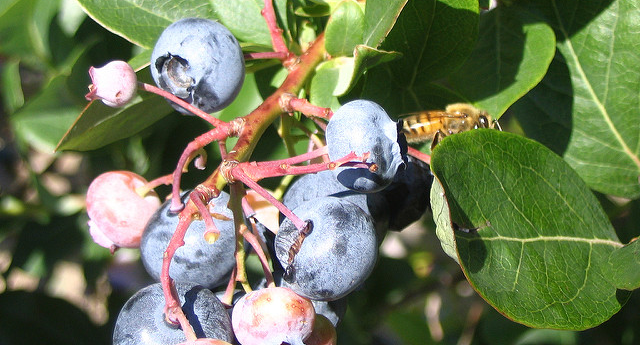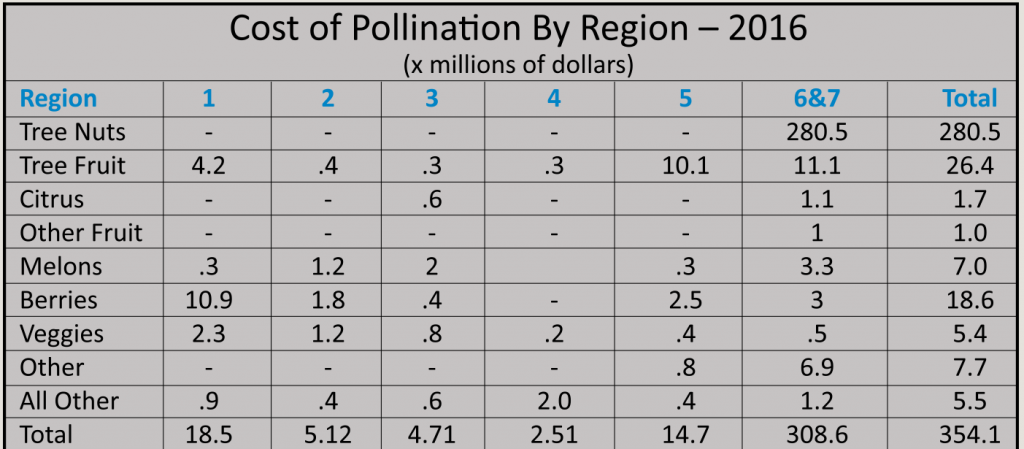USDA NASS released their 2016 Value Of Pollination report in December last year.
By: Kim Flottum
Below are excerpts from the report detailing what crops were monitored, which states are in the regions they detailed and definitions of categories used, along with a chart compiled here showing the relative value of the various categories of crops pollinated. The entire report is available at the link: http://usda.mannlib.cornell.edu/usda/current/CostPoll/CostPoll-12-22-2016.pdf
We’ve already heard discussions on the accuracy of some aspects of this report, but it is brand new, and in our opinion, NASS is to be congratulated on gathering this data and making it available for industry use.
Blueberries had the highest total value of pollination of crops reported in Region 1 during in 2016. The price per colony for blueberries decreased 7 percent to 88.2 dollars per colony in 2016. The price per acre decreased 12 percent to 147 dollars per acre. The total value of pollination for blueberries in Region 1 for 2016 was 5.73 million dollars. The total value for pollination of all crops in Region 1 for 2016 was 18.5 million dollars, down 2 percent from a year ago.
Blueberries had the highest total value of pollination of crops reported in Region 2 2016. The price per colony for blueberries increased 6 percent to 53.7 dollars per colony in 2016. The price per acre increased 6 percent to 81.8 dollars per acre. The total value of pollination for blueberries in Region 2 for 2016 was 1.77 million dollars. The total value of pollination of all crops in Region 2 for 2016 was 5.12 million dollars, down 2 percent from previous year.
Watermelons had the highest total value of pollination of crops reported in Region 3 during in 2016. The price per colony for watermelons decreased 3 percent to 58.7 dollars per colony in 2016. The price per acre increased 23 percent to 59.5 dollars per acre. The total value of pollination for watermelons in Region 3 for 2016 was 1.82 million dollars. The total value of pollination of all crops in Region 3 for 2016 was 4.71 million dollars, down 13 percent from last year.
Pumpkins had the highest total value of pollination of crops reported in Region 4 during 2016. The price per colony for pumpkins was 80.3 dollars per colony in 2016. The price per acre was 26.7 dollars per acre. Pumpkin estimates for 2015 were not published, so no comparison can be made with the previous year. The total value of pollination for pumpkins in Region 4 for 2016 was 201 thousand dollars. The total value of pollination of all crops in Region 4 for 2016 was 2.51 million dollars, up 30 percent from a year ago.
In Region 6 & 7, the average cost per colony for almonds increased 1 percent from 165 dollars per colony to 167 dollars per colony in 2016. The average price per acre, however, decreased from 313 dollars per acre to 287 dollars per acre during that period. The total value of pollination for almonds decreased 3 percent due to less colonies used on almonds in 2016. Almonds were the highest valued crop in that region. The total value of all pollination in Region 6 & 7 for 2016 was 309 million dollars, up slightly from last year.
Apples had the highest total value of pollination of crops reported in Region 5 during in 2016. The price per colony for apples decreased 2 percent to 51.5 dollars per colony in 2016. The price per acre increased 5 percent to 47.6 dollars per acre. The total value of pollination for apples in Region 5 for 2016 was 5.41 million dollars. The total value of pollination of all crops in Region 5 for 2016 was 14.7 million dollars, up 7 percent from previous year.
To improve the reliability and increase the number of estimates which can be published, estimates are published at regional level, based on the regions used for the 2012 Census of Agriculture. Regions 6 and 7 were combined. The states in each region are as follows:
Region 1: Connecticut, Illinois, Indiana, Iowa, Kansas, Massachusetts, Maine, Michigan, Nebraska, New Hampshire, New Jersey, New York, Ohio, Pennsylvania, Rhode Island, Vermont, Wisconsin.
Region 2: Alabama, Delaware, Georgia, Kentucky, Maryland, North Carolina, South Carolina, Tennessee, Virginia, West Virginia.
Region 3: Arkansas, Florida, Louisiana, Missouri, Mississippi, New Mexico, Oklahoma, Texas.
Region 4: Colorado, Minnesota, Montana, Nevada, North Dakota, South Dakota, Utah, Wyoming.
Region 5: Alaska, Idaho, Oregon, Washington.
Region 6 & 7: Arizona, California, Hawaii.
Terms and Definitions of Cost of Pollination Estimates Paid Pollinated Acres: Acreage that an operation paid money to be pollinated by honey bees.
Dollars per Acre: The average price paid by operations to pollinate an acre of crop. Acres pollinated for free or on a nonmonetary basis were not included in this calculation.
Colonies Used: The total colonies used to pollinate a crop; regardless of ownership or if on a paid basis.
Dollars per Colony: The average price paid by operations to use a colony for pollination. Colonies owned by the operation or used on a non-monetary basis were not included.
Total Value of Pollination: The total valuation of all pollination, calculated by multiplying the price per colony by colonies used.
Included Crops Sampled Crops:
- Tree nuts: Almonds, Macadamia nuts
- Tree fruit: Apples, Avocados, Cherries, Mangos, Peaches, Pears, Plums, Prunes
- Citrus: Nectarines, Oranges
- Other fruit: Grapes, Kiwi
- Melons: Cantaloupes, Honeydew, Watermelons
- Berries: Blueberries, Boysenberries, Cranberries, Raspberries, Strawberries
- Vegetables: Cucumber, Pumpkins, Squash, Turnips
- Other Crops: Alfalfa, Buckwheat, Canola, Clover, Sunflowers
Additional Crops:
- Tree nuts: Chestnuts, Hazelnuts, Pecans, Pistachios, Walnuts,
- Tree fruit: Bananas, Papayas, Persimmons, Pomegranates, Citrus: Grapefruit, Lemons, Limes, Kumquats, Mandarins, Tangelos, Tangerines,
- Other fruit: Pineapples, Berries, Currants, Loganberries,
- Vegetables: Artichokes, Asparagus, Beets, Broccoli, Brussel sprouts, Cabbage, Carrots, Cauliflower, Celery, Eggplant, Garlic, Kale, Lettuce, Lima beans, Okra, Peas, Peppers, Potatoes, Snap beans, Spinach,
- Other Crops: Barley, Beans, Coffee, Cotton, Hops, Oats, Peanuts, Sorghum, Soybeans, Tobacco.










